Results of two-stage tests show that dissolved oxygen is not evenly distributed in ponds, even with water exchange and operating mechanical aerators
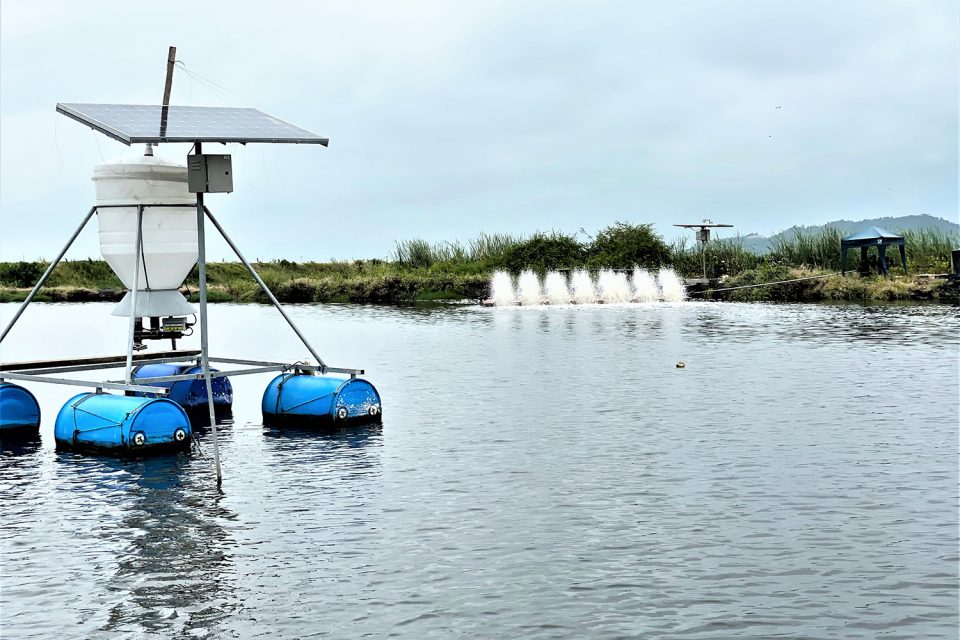
Manufactured shrimp aquafeeds are essential for the optimal development and growth of shrimp throughout its culture cycle, representing the main operating cost of shrimp farms in Latin America during the grow-out phase. Although the Ecuadorian shrimp industry is heterogenous regarding its diverse production conditions, considerable investments in new technologies have been an undeniable force behind the continuous growth of its production volumes.
The main driver behind the technification of pond production is the automation of feed dispersion in grow-out systems (i.e., automatic feeders), allowing significant increases in daily feed distributions and overall feed inputs. In many cases, under the same stocking densities, the number of daily meals were extended from 1-3 meals per day to well over 100, and overall feed input increased by more than 50 percent when switching to automatic feeders. In the context of the Ecuadorian shrimp production systems, acoustic feedback-based feeding systems are the most evident example of the benefits offered by automatic feeding technology.
In Ecuador, shrimp is typically produced at low density (<35 ind./m2) in large, earthen ponds (>5 ha). In these ponds, the feeding areas (total radius around the auto-feeder unit over which feed is dispersed) represent less than 5 percent of the total pond area. Although shrimp move constantly in the pond, having specific feeding locations generates a concentration of shrimp biomass at various times during the day. It is expected that shrimp exhibit higher metabolic rates in these areas due to feeding activities, digestion, crowding and possibly stress. In other words, an overall semi-intensive system is segmented into high concentrations in the feeding locations (with biomasses of up to 10 to 12 kg per cubic meter) and large areas elsewhere in the ponds with much lower shrimp densities. It is expected that the concentration of feed inputs and shrimp activity around the automatic feeders could potentially affect the water and soil quality of these areas.
Furthermore, many of the shrimp farms switching to automatic feeders report increases in feed conversion ratio and higher risk of shrimp dying by asphyxiation towards the end of the cycle, although they rarely observe a decrease in feed demand and consumption. Therefore, it is important to understand the effect that the concentration of the feeding activities has on water and soil quality, so that management protocols may be improved.
The objective of our study was to evaluate the quality of water (salinity, temperature, dissolved oxygen) and soil (organic matter) inside and outside the pond feeding areas throughout various production cycles. We sampled commercial shrimp ponds located in two different environments (low and high salinity) during the two climatic seasons of Ecuador. All ponds were managed using the same feeding technology and production protocols.
Automated feeding systems in pond production of Pacific white shrimp
Study setup
Our study was conducted in two stages between August 2021 and March 2022 in the Province of Guayas, Ecuador. The first one was carried out between August and October 2021 at a low salinity (~5 ppt) farm in the sector of Taura, and the second one was conducted between October 2021 and March 2022 at a shrimp farm in the Sabana Grande sector with salinity ~30 ppt. The shrimp farm in the low salinity environment recirculated 15-20 percent of the total volume of its ponds every day within the farm, while the farm in the brackish water area exchanged about 15 percent of the total volume of its ponds daily with the nearby estuary.
Each pond in the study was equipped with four passive acoustic feeders (AQ1 Systems Pty. Ltd., Tasmania, Australia) placed about 40 meters away from the levee and 100-150 meters from the water inlet gate (Fig. 1). In addition, all ponds had diesel-powered paddlewheel aerators located near the feeding areas, with the equivalent of 1.5 hp/ha in the low salinity ponds and between 1.1 and 3.2 hp/ha in the estuarine farm. The two farms had different strategies regarding the placement of the aerators inside the ponds. At the low salinity shrimp farm, all the aerators were located in such a way that they generated a water flow parallel to the levee with minimal direct influence on the feeding zone, while at the estuarine farm, the aerators were installed diagonally to the levee with their water flow pointing towards the areas covered by the auto-feeders.
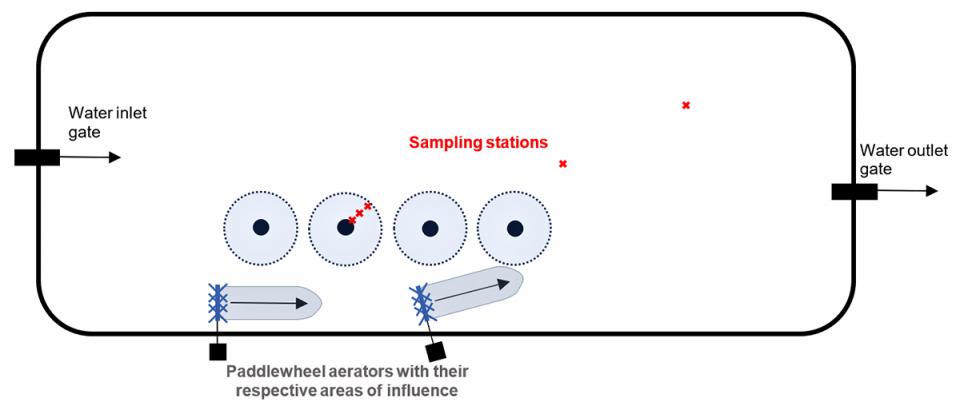
Pond sizes ranged from 8.0 to 11.3 ha and were stocked at a density of 15 to 20 shrimp per square meter. Shrimp in these ponds were all fed throughout the production cycle with the same feed and following the same feeding protocol (i.e., using a feeding table during the first three to four weeks and then switching to the passive acoustic feeding system applying the same feeding schedule). Final yield in all ponds ranged from 2,800 to 3,500 kg/ha. Finally, both farms applied various organic and inorganic products along the culture cycle, to avoid excessive accumulation of organic matter in pond sediments and to help reduce the drying time between consecutive production cycles.
Pond sampling
Each pond was sampled every 15 days from the third to the 14th week of culture, between 10 a.m. and 12 p.m. Five sampling stations were identified in each pond (Fig. 1): three stations inside the feed dispersion radius at 3 meters, 8 meters and 12 meters from the main hopper connected to the hydrophone, and two stations outside the feeding zone in the direction of the water outlet gate. The water column depth at these five sampling stations varied between 0.9 and 1.2 meters.
At each sampling point, water quality parameters were measured at depths of 0.2 meters, 0.6 meters, and 0.8 to 1.0 meters, representing the surface, middle and bottom of the water column, respectively. Salinity, temperature and dissolved oxygen concentrations and saturation levels were measured with a YSI Pro 2030 oxygen meter (Yellow Springs, Ohio, USA).
Soil samples within the feeding area were composed of two sub-samples taken at each sampling point. A single sample was collected at each of the two stations outside the feeding area, then both were combined and analyzed as a single reference point. All soil samples were analyzed at the BioMar laboratory in Durán (Guayas, Ecuador) to determine their organic matter content according to the ignition method (Boyd, 1995).
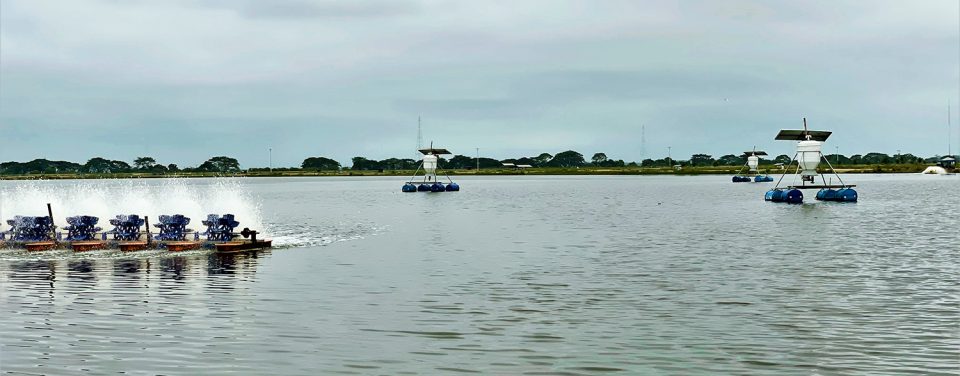
Results and discussion
Low salinity region (Taura), cooler season
Pond water salinity remained stable during the study, with values between 4.7 and 5.6 ppt (5.2 ± 0.2 ppt), regardless of the pond sampled, the sampling date, or the depth at which the sample was taken. This salinity is typical of the Taura region and considered to be at the lower end of the optimum range for the culture of Pacific white shrimp (Litopenaeus vannamei).
The water temperatures reflect the cold season on the Ecuadorian coast, with values fluctuating between 24.1 and 26.8 degrees-C at the time of the measurements (10 a.m. to noon). In this case, we observed a difference along the sampling period with a slight increase in surface water temperature (+1.5 degrees-C) as we approach the end of the year when the warmer season generally begins in this area of Ecuador. In addition, water temperatures were lower at the bottom of the water column compared to the surface (difference of 0.3 degrees-C on average; p=0.001, one-way analysis of variance, ANOVA). This temperature difference could help form two separated layers of water, favoring the appearance of differences in other water parameters between the top and bottom of the water column (mainly during periods of low water movement).
Results for the dissolved oxygen measurements are summarized in Table 1. We observed a stratification of dissolved oxygen in the water column at the time of the measurements, with lower concentrations at the bottom of the ponds. This difference is partly due to the lower photosynthesis rate as light fades with increasing depth in the water column. However, the deficit in dissolved oxygen at the pond bottom is more marked at the sampling points closest to the automatic feeder (3 meters and 8 meters), with only two of the 23 measurements presenting saturation levels of 65 percent or above, while in the other sampling points this critical level was exceeded in 15 of the 45 measurements.
Reis, Automatic shrimp feeders, Table 1
| Dissolved oxygen concentration (mg/L) – Low salinity sector | |||||||
|---|---|---|---|---|---|---|---|
| 3m | 8m | 12m | Ref. 1 | Ref. 2 | Average | ANOVA | |
| Surface | 6.1 ± 1.8ª | 5.9 ± 2.2 | 5.9 ± 2.5 | 6.8 ± 1.8ª | 6.8 ± 2.0 | 6.3 ± 2.0 | p=0.675 |
| Middle | 5.0 ± 1.6ab | 5.2 ± 1.7 | 5.0 ± 1.6 | 5.6 ± 1.1ab | 5.7 ± 1.2 | 5.3 ± 1.4 | p=0.672 |
| Bottom | 3.5 ± 1.1b | 4.1 ± 1.3 | 4.6 ± 1.1 | 5.1 ± 1.1b | 5.2 ± 1.5 | 4.5 ± 1.3 | P=0.011 |
| Average | 4.9 ± 1.8 | 5.1 ± 1.9 | 5.2 ± 1.8 | 5.9 ± 1.5 | 5.9 ± 1.7 | ||
| ANOVA | p=0.001 | p=0.062 | p=0.245 | p=0.016 | p=0.063 | ||
| Dissolved oxygen saturation (%) – Low salinity sector | |||||||
| 3m | 8m | 12m | Ref. 1 | Ref. 2 | Average | ||
| Surface | 77 ± 22 | 74 ± 29 | 74 ± 32 | 86 ± 23 | 86 ± 26 | 79 ± 26 | |
| Middle | 63 ± 20 | 65 ± 21 | 63 ± 20 | 70 ± 13 | 72 ± 16 | 67 ± 18 | |
| Bottom | 44 ± 13 | 51 ± 16 | 57 ± 14 | 64 ± 14 | 65 ± 19 | 56 ± 17 | |
| Average | 62 ± 23 | 63 ± 24 | 65 ± 24 | 73 ± 19 | 74 ± 22 | ||
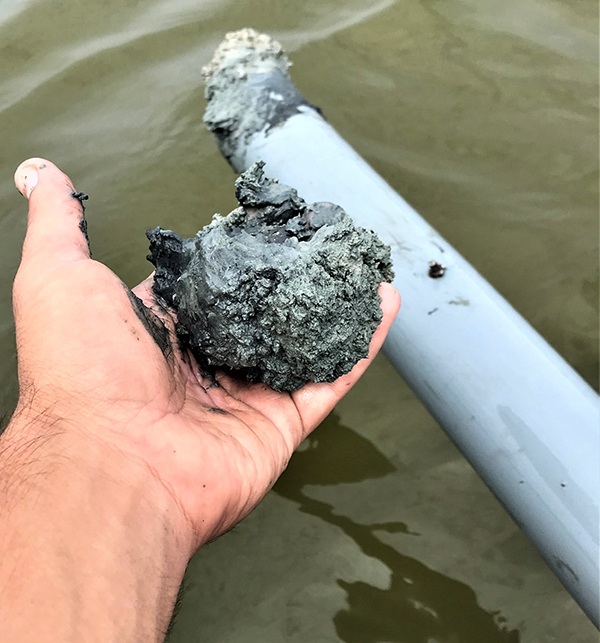
As feeding areas and areas immediately adjacent have higher shrimp densities with higher individual metabolic rate, these should also be hotspots for oxygen consumption. Shrimp are mostly benthic; thus, it is not surprising that oxygen stratification occurs in these areas. It is important to note that, since all the ponds were fed from 10 a.m. to 10 p.m., it is likely that the dissolved oxygen concentration at the bottom of the pond close to the automatic feeders may not have been optimal for the shrimp to convert the feed during the first two to three hours of feeding.
The concentrations of organic matter measured in the sediments are presented in Fig. 2. The values fluctuated between 2.1 percent and 5.9 percent (3.7 ± 0.8 percent) and 35 percent of the samples presented concentrations of 4.0 percent or higher. The relatively high levels of organic matter in these ponds are due to several factors, including the high feeding rates and the agricultural history of the land where this relatively new shrimp farm is located (~5 years of production). As a preventive treatment, ponds received various doses of bioremediators each week, with special emphasis on the treatment of the feeding areas. It is possible that these treatments, together with the aeration protocols, helped prevent further soil degradation.
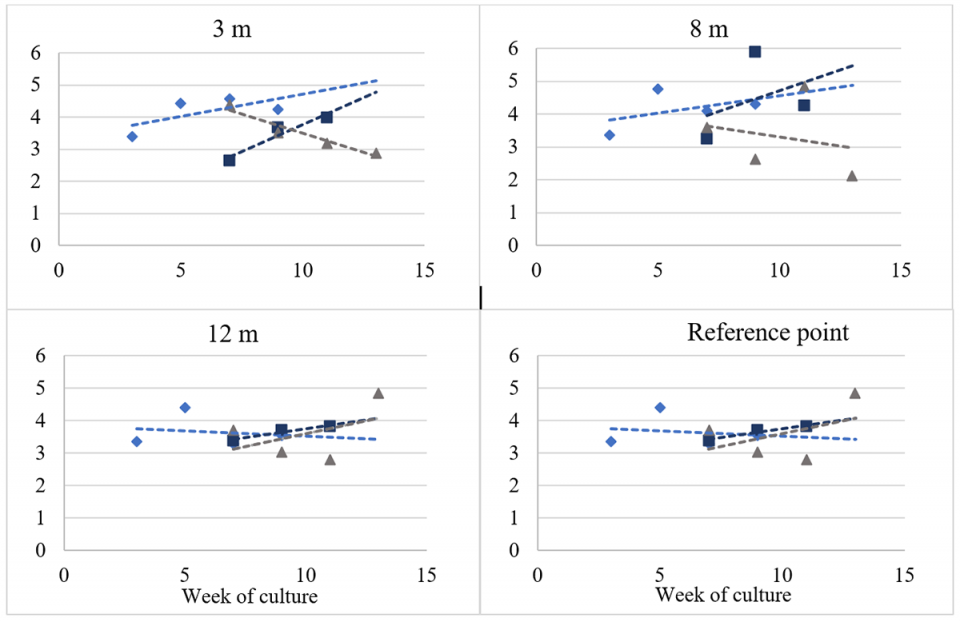
Brackish water region (Sabana Grande), warmer season
At this farm, water salinity remained between 27.0 and 29.0 ppt for much of the study, regardless of the depth at which the sample was taken. However, a decrease to 23.0 ppt was observed in the last week of sampling, reflecting the effect of the accumulated rains between the end of February and the middle of March 2022 in this area of Ecuador.
Water temperatures fluctuated between 24.4 and 30.8 degrees-C at the time of the measurements (10 a.m. to noon), with no significant difference between the three water depths. Again, we observed a difference in surface water temperature along the sampling period, with a pronounced increase (+5 degrees-C) between the first weeks of sampling (November 2021) and the end of the study (March 2022).
Results of the dissolved oxygen measurements are presented in Table 2. On average, the oxygen saturation levels were higher than for the shrimp farm in the low salinity sector. Between 40 and 80 percent of the readings showed saturation levels greater than 65 percent at the bottom of the ponds. These higher dissolved oxygen concentrations reflect, among other factors, the greater luminosity (and photosynthesis) of the warmer season compared to the cooler season.
At this farm, no significant differences were observed between the concentrations of dissolved oxygen at the surface and that at the bottom of the ponds. One factor that could have contributed to maintaining a more homogeneous water column is the location of the aerators pointing to the feeding area in this shrimp farm. In a follow-up study, it will be important to measure the real benefit of the orientation and location of the aerators in these large ponds, not only on the water quality in the feeding area, but also on the production parameters (shrimp growth rate and feed conversion ratio).
Another factor that helps to have a more homogeneous water column is the fact that the shrimp ponds in the brackish water sector are shallower (0.3 to 0.4 meters less water column than for the ponds in the low salinity area). However, it is important to emphasize that a shallower water column represents a lower volume of water and therefore a lower oxygen supply capacity for shrimp farming, which could result in a greater recurrence of episodes of low oxygen concentration during the culture cycle.
Even though no significant differences were observed, the results summarized in Table 2 suggest similar trends in the two shrimp farms, with lower oxygen concentrations at the bottom of the ponds, as well as within the feeding areas. This last observation is due to higher shrimp biomass around the feeders, actively feeding during the measurements.
Reis, Automatic shrimp feeders, Table 2
| Dissolved oxygen concentration (mg/L) – Brackish water sector | |||||||
|---|---|---|---|---|---|---|---|
| 3 meters | 8 meters | 12 meters | Ref. 1 | Ref. 2 | Average | ANOVA | |
| Surface | 6.0 ± 1.8 | 6.1 ± 2.1 | 6.3 ± 1.8 | 6.9 ± 2.1 | 7.0 ± 2.3 | 6.5 ± 2.0 | p=0.458 |
| Middle | 5.2 ± 1.6 | 5.1 ± 1.7 | 5.5 ± 1.6 | 6.2 ± 2.0 | 6.7 ± 2.3 | 5.7 ± 1.9 | p=0.067 |
| Bottom | 4.6 ± 1.7 | 4.7 ± 1.9 | 5.3 ± 1.9 | 5.8 ± 2.0 | 6.2 ± 2.1 | 5.3 ± 2.0 | P=0.094 |
| Average | 5.3 ± 1.8 | 5.3 ± 2.0 | 5.7 ± 1.8 | 6.3 ± 2.1 | 6.6 ± 2.2 | ||
| ANOVA | p=0.085 | p=0.097 | p=0.228 | p=0.292 | p=0.549 | ||
| Dissolved oxygen saturation (percent) – Brackish water sector | |||||||
| 3 meters | 8 meters | 12 meters | Ref. 1 | Ref. 2 | Average | ||
| Surface | 88 ± 27 | 90 ± 31 | 93 ± 28 | 102 ± 33 | 104 ± 36 | 95 ± 31 | |
| Middle | 77 ± 23 | 75 ± 25 | 81 ± 24 | 91 ± 30 | 99 ± 34 | 84 ± 29 | |
| Bottom | 68 ± 26 | 69 ± 27 | 77 ± 28 | 85 ± 30 | 91 ± 32 | 78 ± 29 | |
| Average | 78 ± 26 | 78 ± 29 | 84 ± 27 | 93 ± 31 | 98 ± 34 | ||
The concentrations of organic matter in the sediments of the shrimp farm in the brackish water area are presented in Fig. 3. These concentrations fluctuated between 1.0 percent and 11.0 percent (2.6 ± 1.8 percent), with 15 percent of the samples presenting values of 4.0 percent or higher. The average results were slightly lower than for the low salinity farm. In addition, greater variability was observed among samples from the same pond, as well as between samples of different ponds. This greater variability is explained in part, by the years of shrimp culture use (more than 35 years of continuous operation) and irregular soil constitution in comparison to the other farm.
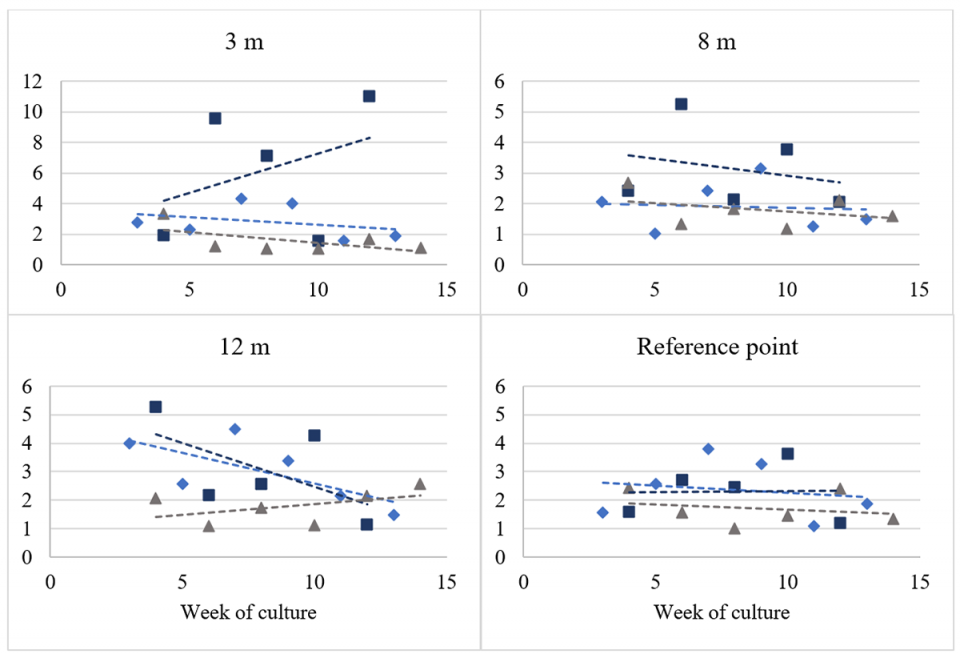
Conclusion
The technical staff of shrimp farms in Ecuador assumes that there is a higher concentration of shrimp around the automatic feeders during the feeding periods. That knowledge is supported by observations during population samplings. However, much of the information on the use of technology in shrimp farming is based on empirical knowledge, jealously protected since it was generated based on sensitive data within a competitive market, such as yields at harvest and feed conversion ratio. The data presented here were generated during a systematic sampling program along with various culture cycles and represent a first attempt at characterizing the feeding areas of large shrimp ponds equipped with acoustic feeders.
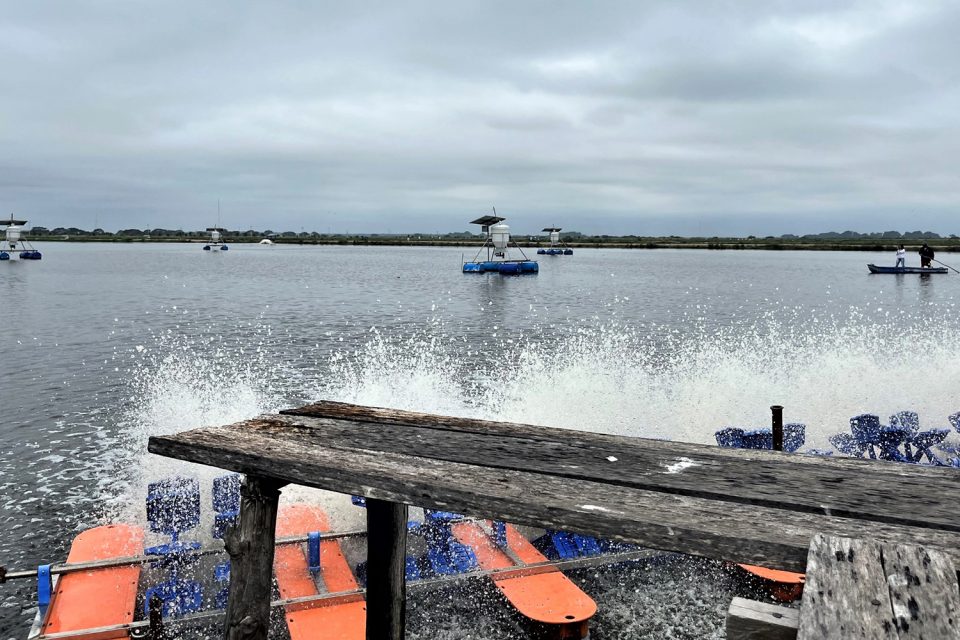
In both shrimp farms, at the sampling stations located outside the feeding areas, we observed higher concentrations of dissolved oxygen in the water (at the middle and bottom of the water column) and lower concentrations of organic matter in the sediments. For half of the ponds sampled, an increase in organic matter was observed along the culture cycle at the stations located closer to the automatic feeders. In addition, we determined an increase in the consumption of dissolved oxygen in the lower half of the water column near the automatic feeders, due to the high concentration of shrimp around the feeding units.
The current trend is to interpret a deficit in dissolved oxygen as a global problem in the pond and is generally associated with the night and early morning hours. Instead, the data presented here demonstrate that dissolved oxygen is not evenly distributed, despite having water flowing in and out of the ponds or the aerators being in operation. In addition, the oxygen saturation levels could be deficient at the bottom of the water column within the feeding areas, despite having supersaturation at the surface or levels close to saturation outside these areas.
At each point and moment in a shrimp pond, the concentration of dissolved oxygen reflects the balance between the processes that generate oxygen (mainly photosynthesis) and the various processes consuming oxygen (respiration of the water column, sediments, and shrimp). Being able to assure acceptable levels of oxygen during the culture cycle is important to maximize the use of manufactured feed by the shrimp (high growth rate, low feed conversion ratio) and support a rapid oxidation of organic compounds in the sediment (leading to a lower probability of toxic compounds accumulating, and the spread of pathogenic bacteria such as vibrios).
Implementing real-time measurements of dissolved oxygen concentration in the areas of highest shrimp concentration should help to better control over this important abiotic parameter.
The data presented here is an important step toward improving the efficiency of shrimp farming under the production model implemented in Latin America.
References available from authors.
Now that you've reached the end of the article ...
… please consider supporting GSA’s mission to advance responsible seafood practices through education, advocacy and third-party assurances. The Advocate aims to document the evolution of responsible seafood practices and share the expansive knowledge of our vast network of contributors.
By becoming a Global Seafood Alliance member, you’re ensuring that all of the pre-competitive work we do through member benefits, resources and events can continue. Individual membership costs just $50 a year.
Not a GSA member? Join us.
Authors
Tagged With
Related Posts
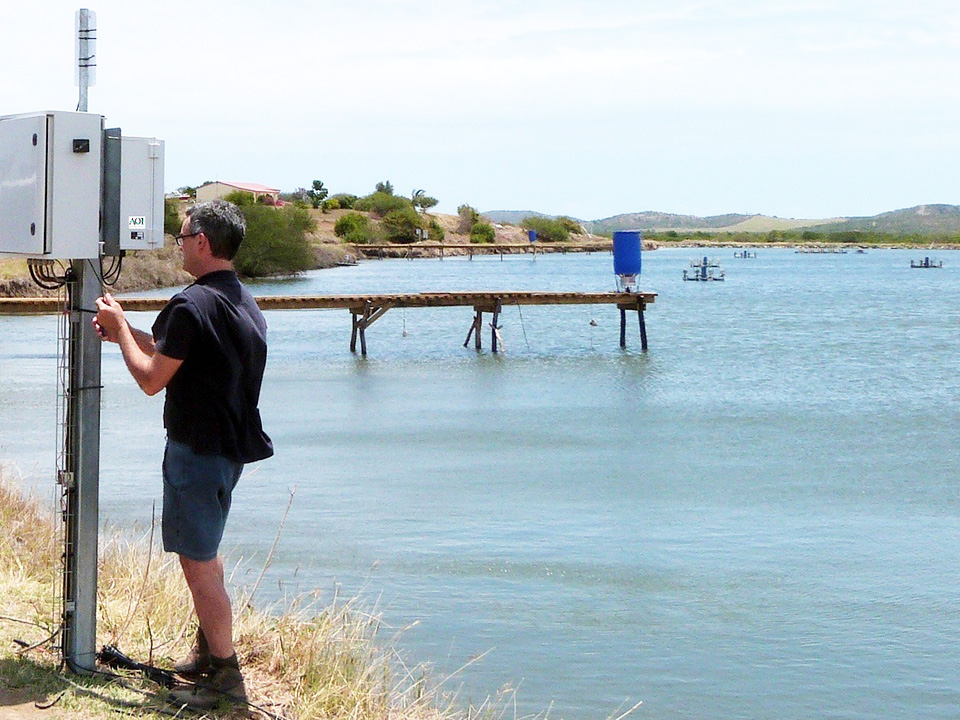
Innovation & Investment
Acoustic control improves feeding productivity at shrimp farms
In systems recently developed for shrimp farms, passive acoustic-based technology enables sensor-based control of multiple automatic feeders. Improved growth and feed conversion have been recorded at commercial farms using the technology.
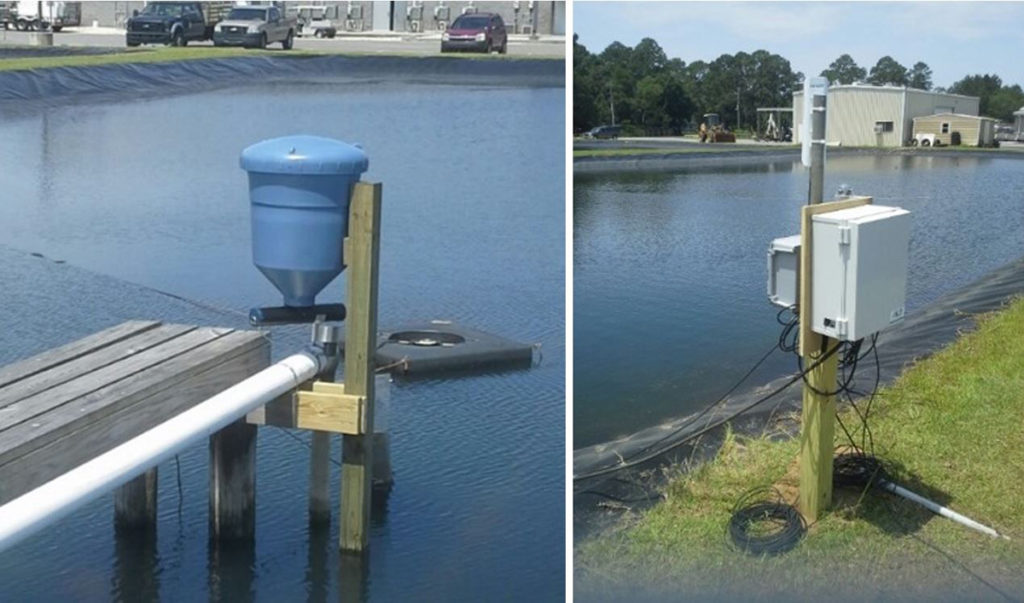
Aquafeeds
Automated feeding systems in pond production of Pacific white shrimp
Results of this study show that automated feeding systems are significantly more efficient than hand feeding in shrimp production ponds and that increases in feed input, application of adaptive technology and training of people to maintain the feeding system must all be considered.
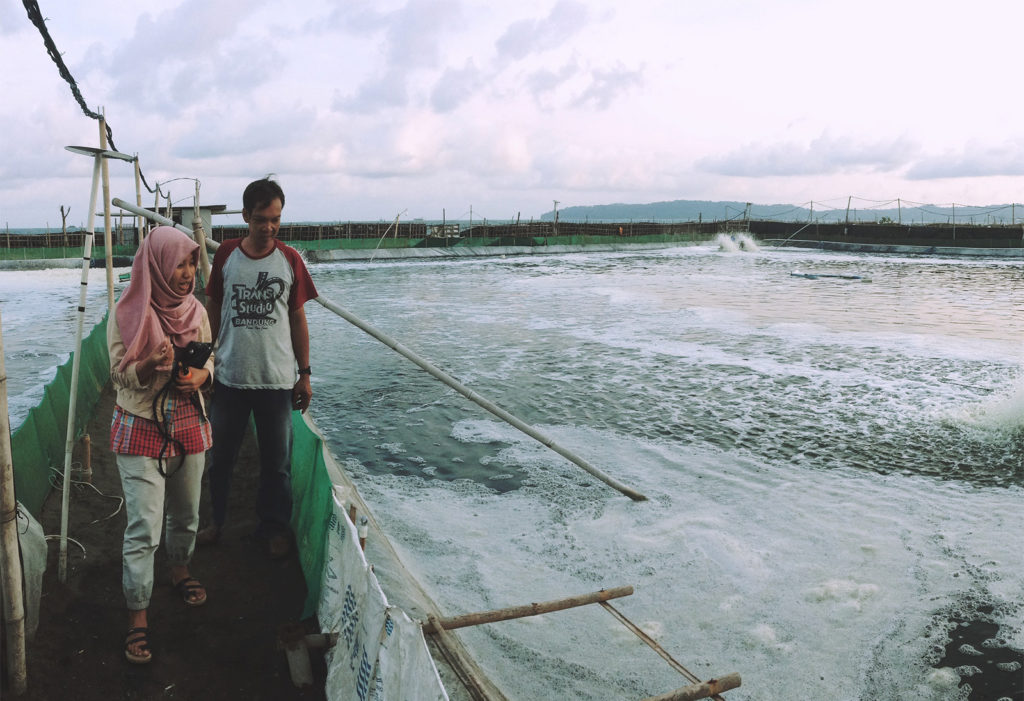
Innovation & Investment
Aqua Insights excerpt: Smart water quality sensors for aquaculture
An excerpt from the April 2022 issue of Aqua Insights looks into the possibilities that Smart water quality sensors provide aquaculture.

Innovation & Investment
Eight digital technologies disrupting aquaculture
Eight digital technologies are disrupting aquaculture and having a profound impact on the way business operates – even displacing some established ones.



